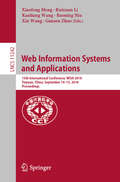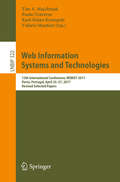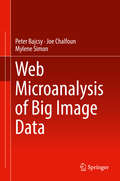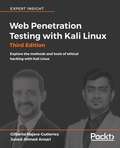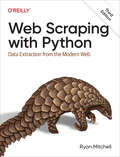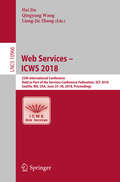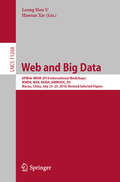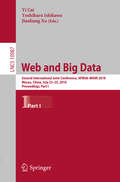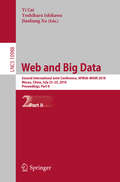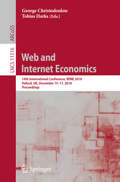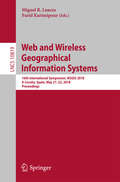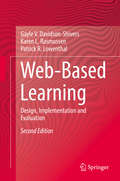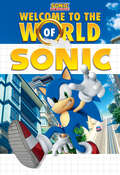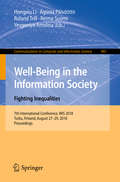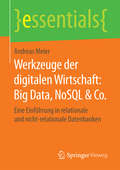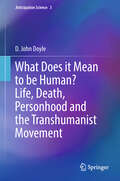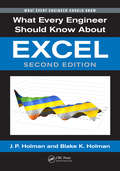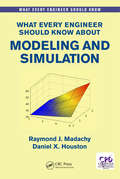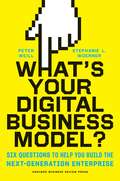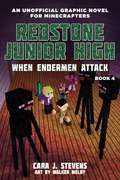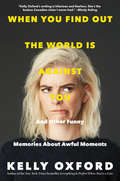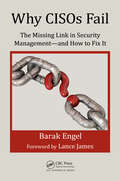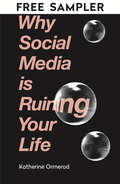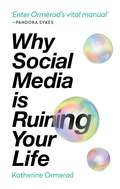- Table View
- List View
Web Information Systems and Applications: 15th International Conference, WISA 2018, Taiyuan, China, September 14–15, 2018, Proceedings (Lecture Notes in Computer Science #11242)
by Xin Wang Xiaofeng Meng Gansen Zhao Ruixuan Li Kanliang Wang Baoning NiuThis book constitutes the refereed proceedings of the 15th International Conference on Web Information Systems and Applications, WISA 2018, held in Taiyuan, China, in September 2018. The 29 full papers presented together with 16 short papers were carefully reviewed and selected from 103 submissions. The papers cover topics such as machine learning and data mining; cloud computing and big data; information retrieval; natural language processing; data privacy and security; knowledge graphs and social networks; query processing; and recommendations.
Web Information Systems and Technologies: 13th International Conference, WEBIST 2017, Porto, Portugal, April 25–27, 2017, Revised Selected Papers (Lecture Notes in Business Information Processing #322)
by Tim A. Majchrzak Karl-Heinz Krempels Valérie Monfort Paolo TraversoThis book constitutes revised selected papers from the 13th International Conference on Web Information Systems and Technologies, WEBIST 2017, held in Porto, Portugal, in April 2017. The purpose of the WEBIST series of conferences is to bring together researches, engineers and practitioners interested in technological advances and business applications of web-based information systems. The 12 full papers presented in this volume were carefully reviewed and selected from originally 77 paper submissions. They contribute to the understanding of relevant trends of current research on Web information systems and technologies, comprising unified interfaces, Progressive Web Apps (PWAs) as well as a mobile device taxonomy, XML and open data processing, the history of Web engineering, web development for end-users, access control, Web platform assessment, rule engines, and scientific blogging.
Web Microanalysis of Big Image Data
by Peter Bajcsy Joe Chalfoun Mylene SimonThis book looks at the increasing interest in running microscopy processing algorithms on big image data by presenting the theoretical and architectural underpinnings of a web image processing pipeline (WIPP). Software-based methods and infrastructure components for processing big data microscopy experiments are presented to demonstrate how information processing of repetitive, laborious and tedious analysis can be automated with a user-friendly system. Interactions of web system components and their impact on computational scalability, provenance information gathering, interactive display, and computing are explained in a top-down presentation of technical details. Web Microanalysis of Big Image Data includes descriptions of WIPP functionalities, use cases, and components of the web software system (web server and client architecture, algorithms, and hardware-software dependencies). The book comes with test image collections and a web software system to increase the reader's understanding and to provide practical tools for conducting big image experiments. By providing educational materials and software tools at the intersection of microscopy image analyses and computational science, graduate students, postdoctoral students, and scientists will benefit from the practical experiences, as well as theoretical insights. Furthermore, the book provides software and test data, empowering students and scientists with tools to make discoveries with higher statistical significance. Once they become familiar with the web image processing components, they can extend and re-purpose the existing software to new types of analyses. Each chapter follows a top-down presentation, starting with a short introduction and a classification of related methods. Next, a description of the specific method used in accompanying software is presented. For several topics, examples of how the specific method is applied to a dataset (parameters, RAM requirements, CPU efficiency) are shown. Some tips are provided as practical suggestions to improve accuracy or computational performance.
Web Penetration Testing with Kali Linux (Third Edition): Explore the methods and tools of ethical hacking with Kali Linux
by Juned Ahmed Ansari Gilberto Nájera-GutiérrezBuild your defense against web attacks with Kali Linux, including command injection flaws, crypto implementation layers, and web application security holes Key Features - Know how to set up your lab with Kali Linux - Discover the core concepts of web penetration testing - Get the tools and techniques you need with Kali Linux Book Description Web Penetration Testing with Kali Linux - Third Edition shows you how to set up a lab, helps you understand the nature and mechanics of attacking websites, and explains classical attacks in great depth. This edition is heavily updated for the latest Kali Linux changes and the most recent attacks. Kali Linux shines when it comes to client-side attacks and fuzzing in particular. From the start of the book, you'll be given a thorough grounding in the concepts of hacking and penetration testing, and you'll see the tools used in Kali Linux that relate to web application hacking. You'll gain a deep understanding of classicalSQL, command-injection flaws, and the many ways to exploit these flaws. Web penetration testing also needs a general overview of client-side attacks, which is rounded out by a long discussion of scripting and input validation flaws. There is also an important chapter on cryptographic implementation flaws, where we discuss the most recent problems with cryptographic layers in the networking stack. The importance of these attacks cannot be overstated, and defending against them is relevant to most internet users and, of course, penetration testers. At the end of the book, you'll use an automated technique called fuzzing to identify flaws in a web application. Finally, you'll gain an understanding of web application vulnerabilities and the ways they can be exploited using the tools in Kali Linux. What you will learn Learn how to set up your lab with Kali Linux Understand the core concepts of web penetration testing Get to know the tools and techniques you need to use with Kali Linux Identify the difference between hacking a web application and network hacking Expose vulnerabilities present in web servers and their applications using server-side attacks Understand the different techniques used to identify the flavor of web applications See standard attacks such as exploiting cross-site request forgery and cross-site scripting flaws Get an overview of the art of client-side attacks Explore automated attacks such as fuzzing web applicationsWho this book is for Since this book sets out to cover a large number of tools and security fields, it can work as an introduction to practical security skills for beginners in security. In addition, web programmers and also system administrators would benefit from this rigorous introduction to web penetration testing. Basic system administration skills are necessary, and the ability to read code is a must.
Web Penetration Testing with Kali Linux - Third Edition: Explore The Methods And Tools Of Ethical Hacking With Kali Linux, 3rd Edition
by Gilberto Nájera-GutiérrezWeb Penetration Testing with Kali Linux - Third Edition shows you how to set up a lab, helps you understand the nature and mechanics of attacking websites, and explains classical attacks in great depth. This edition is heavily updated for the latest Kali Linux changes and the most recent attacks. Kali Linux shines when it comes to client-side attacks and fuzzing in particular. From the start of the book, you'll be given a thorough grounding in the concepts of hacking and penetration testing, and you'll see the tools used in Kali Linux that relate to web application hacking. You'll gain a deep understanding of classicalSQL, command-injection flaws, and the many ways to exploit these flaws. Web penetration testing also needs a general overview of client-side attacks, which is rounded out by a long discussion of scripting and input validation flaws. There is also an important chapter on cryptographic implementation flaws, where we discuss the most recent problems with cryptographic layers in the networking stack. The importance of these attacks cannot be overstated, and defending against them is relevant to most internet users and, of course, penetration testers. At the end of the book, you'll use an automated technique called fuzzing to identify flaws in a web application. Finally, you'll gain an understanding of web application vulnerabilities and the ways they can be exploited using the tools in Kali Linux.
Web Scraping with Python: Collecting More Data From The Modern Web
by Ryan MitchellIf programming is magic, then web scraping is surely a form of wizardry. By writing a simple automated program, you can query web servers, request data, and parse it to extract the information you need. This thoroughly updated third edition not only introduces you to web scraping but also serves as a comprehensive guide to scraping almost every type of data from the modern web.Part I focuses on web scraping mechanics: using Python to request information from a web server, performing basic handling of the server's response, and interacting with sites in an automated fashion. Part II explores a variety of more specific tools and applications to fit any web scraping scenario you're likely to encounter.Parse complicated HTML pagesDevelop crawlers with the Scrapy frameworkLearn methods to store the data you scrapeRead and extract data from documentsClean and normalize badly formatted dataRead and write natural languagesCrawl through forms and loginsScrape JavaScript and crawl through APIsUse and write image-to-text softwareAvoid scraping traps and bot blockersUse scrapers to test your website
Web Services – ICWS 2018: 25th International Conference, Held as Part of the Services Conference Federation, SCF 2018, Seattle, WA, USA, June 25-30, 2018, Proceedings (Lecture Notes in Computer Science #10966)
by Hai Jin Qingyang Wang Liang-Jie ZhangThis volume constitutes the proceedings of the 16th International Conference on Web Services, ICWS 2018, held as Part of SCF 2018 in Seattle, WA, USA in June 2018. The 31 full papers together with 1 short paper published in this volume were carefully reviewed and selected from 116 submissions. They are organized in topical sections such as Web Services, RESTful web services, Web Services Description Langugage, Universal Description Discovery and Integration, Service discovery and interfaces, Domain-specific security and privacy architectures, Location bases services, Sercurity Services and Markup languages.
Web and Big Data: APWeb-WAIM 2018 International Workshops: MWDA, BAH, KGMA, DMMOOC, DS, Macau, China, July 23–25, 2018, Revised Selected Papers (Lecture Notes in Computer Science #11268)
by Haoran Xie Leong Hou UThis book constitutes the thoroughly refereed post-conference proceedings of the First APWeb-WAIM 2018 Workshops, held jointly with the Second International Joint Conference APWeb-WAIM 2018 in Macau, China, in July 2018. The 31 full papers presented were carefully reviewed and selected from 44 submissions. The papers originating from five workshops present cutting-edge ideas, results, experiences, techniques, and tools from all aspects of web data management with the focus on mobile web data analytics; knowledge graph management and analysis; data management and mining on MOOCs; Big data analytics for healthcare; data science.
Web and Big Data: Second International Joint Conference, APWeb-WAIM 2018, Macau, China, July 23-25, 2018, Proceedings, Part I (Lecture Notes in Computer Science #10987)
by Yoshiharu Ishikawa Jianliang Xu Yi CaiThis two-volume set, LNCS 10987 and 10988, constitutes the thoroughly refereed proceedings of the Second International Joint Conference, APWeb-WAIM 2018, held in Macau, China in July 2018.The 40 full papers presented together with 30 short papers, 6 demonstration papers and 3 keynotes were carefully reviewed and selected from 168 submissions. The papers are organized around the following topics: Text Analysis, Social Networks, Recommender Systems, Information Retrieval, Machine Learning, Knowledge Graphs, Database and Web Applications, Data Streams, Data Mining and Application, Query Processing, Big Data and Blockchain.
Web and Big Data: Second International Joint Conference, APWeb-WAIM 2018, Macau, China, July 23-25, 2018, Proceedings, Part II (Lecture Notes in Computer Science #10988)
by Yoshiharu Ishikawa Jianliang Xu Yi CaiThis two-volume set, LNCS 10987 and 10988, constitutes the thoroughly refereed proceedings of the Second International Joint Conference, APWeb-WAIM 2018, held in Macau, China in July 2018.The 40 full papers presented together with 30 short papers, 6 demonstration papers and 3 keynotes were carefully reviewed and selected from 168 submissions. The papers are organized around the following topics: Text Analysis, Social Networks, Recommender Systems, Information Retrieval, Machine Learning, Knowledge Graphs, Database and Web Applications, Data Streams, Data Mining and Application, Query Processing, Big Data and Blockchain.
Web and Internet Economics: 14th International Conference, WINE 2018, Oxford, UK, December 15–17, 2018, Proceedings (Lecture Notes in Computer Science #11316)
by George Christodoulou Tobias HarksThis book constitutes the thoroughly refereed proceedings of the 14th International Conference on Web and Internet Economics, WINE 2018, held in Oxford, UK, in December 2018. The 28 full papers presented were carefully reviewed and selected from 119 submissions. The papers reflect the work of researchers in theoretical computer science, artificial intelligence, and microeconomics who have joined forces to tackle problems at the intersection of computation, game theory and economics.
Web and Wireless Geographical Information Systems: 16th International Symposium, W2GIS 2018, A Coruña, Spain, May 21–22, 2018, Proceedings (Lecture Notes in Computer Science #10819)
by Miguel R. Luaces Farid KarimipourThis book constitutes the refereed proceedings of the 16th International Symposium on Web and Wireless Geographical Information Systems, W2GIS 2018, held in A Coruña, Spain, in May 2018. The 15 full papers included in the volume were carefully reviewed and selected from 20 submissions. They deal with theoretical, technical, and practical issues in the field of wireless and Internet technologies suited for the dissemination, usage, and processing of geo-referenced data.
Web-Based Learning
by Gayle V. Davidson-Shivers Karen L. Rasmussen Patrick R. LowenthalThis second edition is a practical, easy-to-read resource on web-based learning. The book ably and clearly equips readers with strategies for designing effective online courses, creating communities of web-based learners, and implementing and evaluating based on an instructional design framework. Case example, case studies, and discussion questions extend readers skills, inspire discussion, and encourage readers to explore the trends and issues related to online instructional design and delivery.
Welcome to the World of Sonic (Sonic the Hedgehog)
by Lloyd CordillGet a crash course in all things Sonic the Hedgehog in this introductory handbook, featuring a sheet of stickers from the world of Sonic!Everyone knows that Sonic the Hedgehog is the fastest hero in the world! He has thwarted Dr. Eggman's evil schemes time and time again with his supersonic speed and cool blue spikes. But what else should you know about the world of Sonic? Learn all about Tails, Amy, Knuckles, and the rest of Sonic's gang, and get to know the stories behind some of Sonic's greatest victories. This handbook is the perfect introduction to one of the most beloved video game characters of all time!
Well-Being in the Information Society. Fighting Inequalities: 7th International Conference, WIS 2018, Turku, Finland, August 27-29, 2018, Proceedings (Communications in Computer and Information Science #907)
by Reima Suomi Hongxiu Li Ágústa Pálsdóttir Roland Trill Yevgeniya AmelinaThis book constitutes the refereed proceedings of the 7th International Conference on Well-Being in the Information Society, WIS 2018, held in Turku, Finland, in August 2018.The 19 revised full papers presented were carefully reviewed and selected from 42 submissions. With the core topic "Fighting Inequalities" WIS 2018 focused on innovations and fresh ideas in the cross-section of information society and health as understood in a wide sense. The papers presented in this volume are organized along the following broad topics: digital society and e-health.
Werkzeuge der digitalen Wirtschaft: Eine Einführung in relationale und nicht-relationale Datenbanken (essentials)
by Andreas MeierDas essential f#65533;hrt in Big Data ein und erl#65533;utert die wichtigsten Werkzeuge zur Nutzung von SQL- wie NoSQL-Technologien. Neben semantischer Datenmodellierung, Abfragesprachen, Konsistenzgew#65533;hrung mit ACID oder BASE werden NoSQL-Datenbanken vorgestellt und organisatorische Aspekte des Datenmanagements erl#65533;utert. Der Leser erh#65533;lt mit diesem Kompendium die wichtigsten Grundlagen sowohl zu SQL- wie auch zu NoSQL-Datenbanken.
What Does it Mean to be Human? Life, Death, Personhood and the Transhumanist Movement (Anticipation Science #3)
by D. John DoyleThis book is a critical examination of the philosophical and moral issues in relation to human enhancement and the various related medical developments that are now rapidly moving from the laboratory into the clinical realm. In the book, the author critically examines technologies such as genetic engineering, neural implants, pharmacologic enhancement, and cryonic suspension from transhumanist and bioconservative positions, focusing primarily on moral issues and what it means to be a human in a setting where technological interventions sometimes impact strongly on our humanity. The author also introduces the notion that death is a process rather than an event, as well as identifies philosophical and clinical limitations in the contemporary determination of brain death as a precursor to organ procurement for transplantation. The discussion on what exactly it means to be dead is later applied to explore philosophical and clinical issues germane to the cryonics movement. Written by a physician/ scientist and heavily referenced to the peer-reviewed medical and scientific literature, the book is aimed at advanced students and academics but should be readable by any intelligent reader willing to carry out some side-reading. No prior knowledge of moral philosophy is assumed, as the various key approaches to moral philosophy are outlined early in the book.
What Every Engineer Should Know About Excel (What Every Engineer Should Know #50)
by J. P. Holman Blake K. Holman<p>Understanding the powerful computational and graphics capabilities of Microsoft Excel is an enormous benefit to engineers and technical professionals in almost any field and at all levels of experience. What Every Engineer Should Know About Excel is a practical guide to unlocking the features and functions of this program, using examples and screenshots to walk readers through the steps to build a strong understanding of the material. <p>This second edition is updated to reflect the latest version of Excel (2016) and expands its scope to include data management, connectivity to external data sources, and integration with "the cloud" for optimal use of the Excel product. It also introduces the ribbon bar navigation prevalent in Microsoft products beginning with the 2007 version of MS Office. Covering a variety of topics in self-contained chapters, this handy guide will also prove useful for professionals in IT, finance, and real estate.</p>
What Every Engineer Should Know About Modeling and Simulation (What Every Engineer Should Know)
by Raymond J. Madachy Daniel HoustonThis practical book presents fundamental concepts and issues in computer modeling and simulation (M&S) in a simple and practical way for engineers, scientists, and managers who wish to apply simulation successfully to their real-world problems. It offers a concise approach to the coverage of generic (tool-independent) M&S concepts and enables engineering practitioners to easily learn, evaluate, and apply various available simulation concepts. Worked out examples are included to illustrate the concepts and an example modeling application is continued throughout the chapters to demonstrate the techniques. The book discusses modeling purposes, scoping a model, levels of modeling abstraction, the benefits and cost of including randomness, types of simulation, and statistical techniques. It also includes a chapter on modeling and simulation projects and how to conduct them for customer and engineer benefit and covers the stages of a modeling and simulation study, including process and system investigation, data collection, modeling scoping and production, model verification and validation, experimentation, and analysis of results.
What's Your Digital Business Model?: Six Questions to Help You Build the Next-Generation Enterprise
by Peter Weill Stephanie Woerner<p>What is your digital business model? While many leaders of companies recognize the threat from digital--and the potential opportunity--they lack a common language or a compelling framework to help them assess it and, more importantly, to direct them. They don't know how to think about their digital business model. In this probing and practical book, Peter Weill and Stephanie Woerner provide much-needed tools, self-assessments, motivating examples, and key financial analyses of where the profits will likely be made. <p>Based on five years of study at the MIT Center for Information Systems Research, the book provides a powerful yet simple framework that has been field-tested globally with more than a dozen senior management teams. The authors found that digitization is moving companies' business models on two dimensions: from value chains to digital ecosystems, and from a fuzzy understanding of the needs of end customers to a sharper one. Looking at these dimensions in combination results in four distinct business models, each with different capabilities: (1) Supplier, (2) Omni-channel, (3) Modular Producer, and (4) Ecosystem Driver. The framework helps companies clarify where they are currently in an increasingly digital business landscape and highlights what's needed to move toward another, higher-value digital business model. <p>In meeting the growing challenge to "go digital," this smart book will help you grapple with the threats, respond to the opportunities, and create winning digital strategies.</p>
When Endermen Attack (Redstone Junior High #4)
by Cara J. StevensWinter has come to Redstone Junior High once again, and with it comes holiday celebrations, snowball combat practice, and loads of outdoor fun. But even though the threat of Smite and his henchmen has passed, a new, sinister force lurks in the dark hallways of the school. Strange blocks begin to appear in random places throughout the school, and students have been hearing eerie sounds coming from its abandoned corridors. Pixel, Sky, and Umal team up to figure out what’s tormenting their school and why. <p><p> To make matters worse, Tina and her followers are determined to work against Pixel. What follows is a griefing war that spares no one—not even the teachers or Principal Redstone. As the kids discover more about the lanky creatures who are terrorizing their school, it becomes painfully clear that they must put aside their differences to unite against a common enemy. Will a mob invasion actually bring the students together, or will Redstone Junior High remain haunted forever?
When You Find Out the World Is Against You: And Other Funny Memories About Awful Moments
by Kelly Oxford“Kelly is part geek, part freak. When You Find Out The World Is Against You shows us ourselves: our sensitivities, our awkward moments, our strange desires. She takes us through summer camp, dating, rape culture, Trump, death . . . Kelly Oxford c’est moi.” — James Franco“Two things I’m grateful for: how imperfect Kelly Oxford is at life and decision-making, and how terrific she is at writing about what a goddamn mess she is.” — Patton Oswalt“Kelly Oxford’s writing is hilarious and fearless. She’s the badass Canadian sister I never had.” — Mindy Kaling“I have worshipped the mind of Kelly Oxford for eons. Kelly Oxford’s concise, whip-smart observations feel eerily universal. When You Find Out the World is Against You shows that there is something to be learned from even the most absurd or devastating moments of life.” — Jill Soloway“Kelly Oxford is a beautiful writer. She finds beauty in the mundane and humor in everyday eccentricities. She is our present-day, funny Joan Didion.” — Gia Coppola
Why CISOs Fail: The Missing Link in Security Management--and How to Fix It (Internal Audit and IT Audit)
by Barak EngelThis book serves as an introduction into the world of security and provides insight into why and how current security management practices fail, resulting in overall dissatisfaction by practitioners and lack of success in the corporate environment. The author examines the reasons and suggests how to fix them. The resulting improvement is highly beneficial to any corporation that chooses to pursue this approach or strategy and from a bottom-line and business operations perspective, not just in technical operations. This book transforms the understanding of the role of the CISO, the selection process for a CISO, and the financial impact that security plays in any organization.
Why Social Media is Ruining Your Life
by Katherine Ormerod**FREE SAMPLER**'This book is a call to arms from the eye of the storm'- Emma Gannon, author of The Multi Hyphen MethodDo you ever obsess about your body? Do you lie awake at night, fretting about the state of your career? Does everyone else's life seem better than yours? Does it feel as if you'll never be good enough? Get a first glimpse of Why Social Media is Ruining Your Life with this exclusive free sampler, and learn how to tackle head on the pressure cooker of comparison and unreachable levels of perfection that social media has created in our modern world.In this book, Katherine Ormerod meets the experts involved in curating, building and combating the most addictive digital force humankind has ever created. From global influencers - who collectively have over 10 million followers - to clinical psychologists, plastic surgeons and professors, Katherine uncovers how our relationship with social media has rewired our behavioural patterns, destroyed our confidence and shattered our attention spans.Why Social Media is Ruining Your Life is a call to arms that will provide you with the knowledge, tactics and weaponry you need to find a more healthy way to consume social media and reclaim your happiness.
Why Social Media is Ruining Your Life
by Katherine OrmerodDo you ever obsess about your body? Do you lie awake at night, fretting about the state of your career?Does everyone else's life seem better than yours? Does it feel as if you'll never be good enough? Why Social Media is Ruining Your Life tackles head on the pressure cooker of comparison and unreachable levels of perfection that social media has created in our modern world.In this book, Katherine Ormerod meets the experts involved in curating, building and combating the most addictive digital force humankind has ever created. From global influencers - who collectively have over 10 million followers - to clinical psychologists, plastic surgeons and professors, Katherine uncovers how our relationship with social media has rewired our behavioural patterns, destroyed our confidence and shattered our attention spans.Why Social Media is Ruining Your Life is a rallying cry that will provide you with the knowledge, tactics and weaponry you need to find a more healthy way to consume social media and reclaim your happiness.Reviews for Why Social Media is Ruining Your Life:'This book is a call to arms from the eye of the storm'- Emma Gannon, author of The Multi-Hyphen Method'Enter Ormerod's vital manual, which will help you navigate social media and turn it not into a weapon, but a useful tool' - Pandora Sykes
